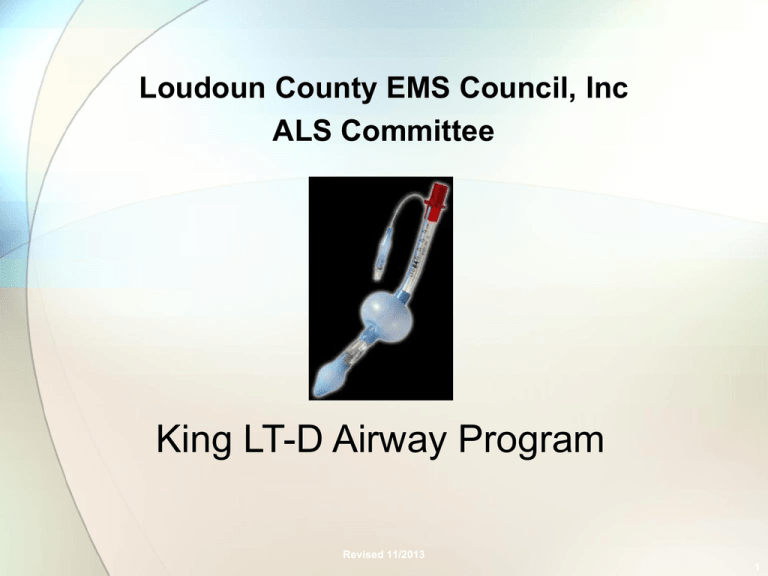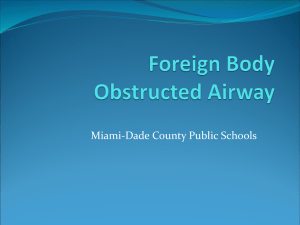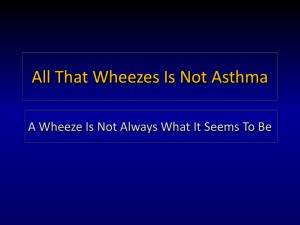King-Airway-2013
advertisement

Loudoun County EMS Council, Inc ALS Committee King LT-D Airway Program Revised 11/2013 1 King LT-D Airway • It is a supraglottic device • Also known as a blind insertion Airway Device (BIAD) • Proximal cuff blocks oropharynx • Distal cuff blocks esophagus Revised 11/2013 2 Five Sizes 2.0 25ml-35ml • Height of 35-45 Inches 2.5 4.0 60ml-80ml • Height of 5-6 Feet 30ml-40ml • Height of 41-51 Inches 5.0 70ml-90ml • Height of > 6 Feet 3.0 45ml-60ml • Height of 4-5 Feet Colors for the King LTD do not correlate with Broselow colors. Use the LMA # for the King Airway size. 3 Other Accessories • Proper BSI • BVM Need Picture • Oral airway • Tape • Water-based lubricant • Stethoscope Revised 11/2013 4 Standing Orders for King Airway insertion • When the patient is pulseless and apneic • When the patient does not have a gag reflex (accepts an oral airway) • For ALS providers as an alternative if difficulty intubating • On-Line Medical Control must be obtained for any other situation Revised 11/2013 5 Contraindications for the use of the King Airway • • • • Patient is ALIVE! Patient is under 35 inches Patient has a gag reflex Patient has ingested a caustic substance Revised 11/2013 6 Use of the King Airway • When used in conjunction with AED insertion is considered following: • All Shocks Completed • 3 No Shocks • Complicated Airway (Med-Control Only) Revised 11/2013 7 King Airway Insertion 1 of 7 Prepare Your Equipment Revised 11/2013 8 King Airway Insertion 2 of 7 Check tube and balloon Lubricate back of tube only Revised 11/2013 9 King Airway Insertion 3 of 7 INSERTION • Pre-Oxygenate patient for at least 1 minute • Place patient’s head and neck in a neutral position • Remove Oropharyngeal (O.P.) Airway • Grasp tongue and jaw • Lift the tongue and jaw anteriorly (tonguejaw-lift) • Hold the King Airway at the connector area as you would a pencil Revised 11/2013 10 King Airway Insertion 4 of 7 • Insert the tube with the blue line facing the corner of the mouth • As the tube passes behind the tongue, continue to insert while rotating tube until blue line is mid line Revised 11/2013 11 King Airway Insertion 5 of 7 • Insert the tube until the base of the connector is at the level of the teeth or gums. • Inflate balloon with the appropriate amount of air based on size used. Revised 11/2013 12 King Airway Insertion 6 of 7 CONFIRMATION • Attach a BVM to the KING Airway and while bagging the patient, gently withdraw the tube until ventilation becomes easy and free flowing • Confirm chest rise and lung sounds • Capnography may be used to confirm placement Revised 11/2013 13 King Airway Insertion 7 of 7 Securing the Device • After placement has been verified (to include breath sounds) • Insert an oral airway to prevent the patient from biting the tube. • Secure the tube using tape and C-collar. Revised 11/2013 14 When to remove the King Airway • The King Airway should only be removed if patient regains a gag reflex and begins to “fight” (reject) the tube Revised 11/2013 15 How to remove the King Airway • Make sure suction is available and ready • Remove tape and airway • Lay patient on their side • Deflate cuff • Slowly remove tube • Suction patient as needed Revised 11/2013 16 REVIEW QUESTIONS Revised 11/2013 17 In Loudoun County, you have standing orders to use the King Airway on patients that are ________ . Pulseless and Apneic Revised 11/2013 18 When using the King Airway, inflate Size 4 (Red) with __ to __ cc of air and the Size 5 (Purple) with __ to __ cc of air. Red 60-80 cc Purple 70-90 cc Revised 11/2013 19 When using the King Airway, inflate Size 3 (Yellow) with __ to __ cc of air and the Size 2.5 (Orange) with __ to __ cc of air. Yellow 45-60 cc Orange 30-40 cc Revised 11/2013 20 When using the King Airway, inflate Size 2 (Green) with __ to __ cc of air. Green 25-35 cc Revised 11/2013 21 The Cuff (Balloon) should be inflated after assuring chest rise? TRUE or FALSE False Revised 11/2013 22 If you do not get chest rise when first ventilating the King Airway, you should _______ . Slightly pull it back and attempt to ventilate Revised 11/2013 23 You should secure the King Airway in place using __________. Collar Tape Bite Block Revised 11/2013 24 The King Airway should only be used on patients that are ____ inches or taller. 35 Revised 11/2013 25 The King Airway should be inserted until __________ . The teeth or gums are at the base of the connector Revised 11/2013 26 The EDD (Esophageal Detector Device) should be used to check King Airway placement. TRUE / FALSE False Revised 11/2013 27 Which medications can be administered through the King Airway? None Revised 11/2013 28 When used in conjunction with an AED, the King Airway should be inserted after the 3rd shock or 3rd No Shock during a cardiac arrest. TRUE / FALSE True Revised 11/2013 29








